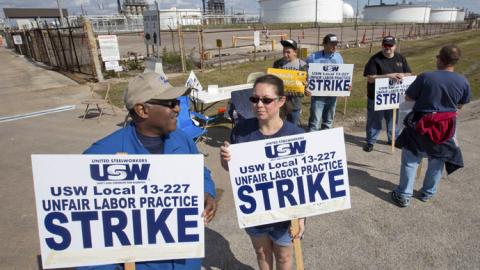Almost Two-Thirds of People in the Labor Force Do Not Have A College Degree
Still Working Hard: An Update on the Share of Older Workers in Physically Demanding Jobs
Almost Two-Thirds of People in the Labor Force Do Not Have A College Degree
Robert E. Scott and David Cooper
Economic Policy Institute
http://www.epi.org/publication/almost-two-thirds-of-people-in-the-labor-force-do-not-have-a-college-degree/
Almost two-thirds of people in the labor force (65.1 percent) do not have a college degree. In fact, people without a college degree (which includes those without a high school degree, with a high school degree, some college education, and an associates’ degrees) make up the majority of the labor force in every state but the District of Columbia. Mississippi has the highest share of non-college educated workers (75.7 percent) while Massachusetts and the District of Columbia have the lowest shares (51 percent and 33.7 percent, respectively).
It is no secret that wages for typical workers have stagnated over the past 35 years. The lagging recovery of construction and manufacturing sectors, two sectors which traditionally provide strong wages for workers without college degrees, is one reason for this wage stagnation. Trade agreements like the Trans-Pacific Partnership threaten to make the possibility of strong, middle-class jobs even more elusive for non-college educated workers.
We cannot solve the problem of low and stagnating wages for non-college educated workers by expecting everyone to pursue more education. We need solutions that will raise wages for all workers, regardless of educational attainment. These solutions include raising the minimum wage, strengthening collective bargaining rights, prioritizing very low rates of unemployment through monetary policy, and reducing our trade deficit by stopping destructive currency manipulation.
Still Working Hard: An Update on the Share of Older Workers in Physically Demanding Jobs
Cherrie Bucknor and Dean Baker
CEPR
March 2016
http://cepr.net/publications/reports/still-working-hard
Executive Summary
A recurring theme in debates over Social Security policy is that workers should be encouraged to work later into their lives by raising the age at which they can get full benefits. Implicit in this argument is that most workers are in a situation where they would be able to work to an older
age; however, many older workers stop working because they can no longer meet the physical demands of their job.
In 2010, CEPR did an analysis that examined the percentage of older workers (ages 58 and over) who either worked in physically demanding jobs or in difficult work conditions. This paper is an update of that earlier study and is based on data from 2014.
Using data from the Current Population Survey (CPS) and Occupational Information Network (O*NET) it finds that in 2014, 8.0 million workers ages 58 and older (34.5 percent) had physically demanding jobs, while 5.1 million workers ages 58 and older (22.1 percent) had jobs with difficult working conditions. About 10.2 million workers ages 58 and older (43.8 percent) were employed either in physically demanding jobs or jobs with difficult working conditions. The workers who were most likely to be in these jobs were Latinos, the least educated (less than a high school diploma), immigrants, and the lowest wage earners.
Physically demanding jobs include general physical activities, handling and moving objects, spending significant time standing, walking or running, making repetitive motions, or having any highly physically demanding work. Highly physically demanding jobs require dynamic, explosive, static, or trunk strength, bending or twisting of the body, stamina, maintaining balance, or kneeling or crouching. Difficult working conditions include working in a cramped workspace, labor outdoors, or exposure to abnormal temperatures, contaminants, hazardous equipment, whole body vibration, or distracting or uncomfortable noise.
The study also finds:
- 37.0 percent of male workers ages 58 and older had jobs that involved any general physical demand, as did 31.7 percent of female workers. These percentages have changed little since 2009, although the absolute numbers have increased since more older people are now working.
- 51.0 percent of older Latino workers had physically demanding jobs, with 9.1 percent having jobs with high physical demands. By comparison, the percentages for Blacks were 38.9 percent and 4.3 percent, respectively and for White workers 31.8 percent and 2.8 percent.
- Older workers with less than a high school diploma had the highest share of workers in physically demanding jobs, with 68.4 percent in jobs with some physical demands and 12.8 percent in jobs with high physical demands. In contrast, only 22.7 percent of workers with a college degree were in physically demanding jobs, and 1.4 percent were in jobs with high physical demands.
- 46.6 percent of immigrant workers ages 58 and older had physically demanding jobs, compared to 32.7 percent for non-immigrant workers.
- 54.8 percent of older workers in the bottom wage quintile had physically demanding jobs compared to 16.2 percent of those in the top quintile. The share in jobs with high physical demands was 6.4 percent for the bottom quintile and just 1.7 percent for those in the top quintile.
Read the remainder of the report here.


Spread the word